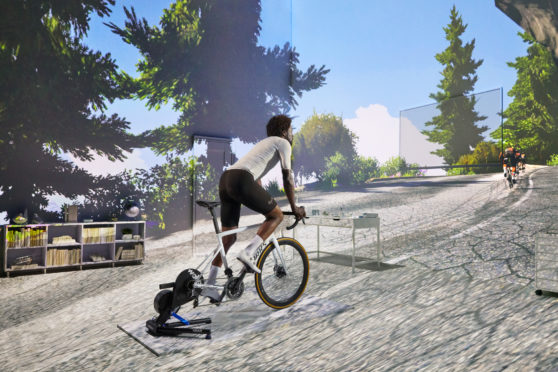My riding habits have changed somewhat recently.
For a start, my trips to warmer climes have been cancelled for the foreseeable future, so my usual rides up the long, forested climes of the volcanic landscapes in Tenerife and Gran Canaria will have to wait until 2021.
Back home I have been riding short loops, close to home as part of our prescribed one hour per day of daily outdoor exercise.
On these I have been accompanied by one of my children, usually in an effort to try to avert World War Three instigated by cabin fever and close proximity to each other for long periods of time.
We are all trying to learn how to live and work with each other, and exercise and fresh air always help to reset minds and focus them on what is important, rather than who has been playing on the Nintendo Switch more than the other when they should have been doing some schoolwork.

During this time I have also rediscovered my love for indoor training, using virtual worlds to ride in.
In recent years, this phenomenon has become a major part of cycling with companies springing up all over the place offering the chance to cycle on an indoor bike trainer that connects via bluetooth to a computer generated virtual world.
Once in the world you can participate in races, just ride around the roads and tracks, or meet up with friends. You can use a normal turbo trainer, where the back wheel clips into a stand and rotates a resistance wheel, and then ride, but for the full experience using a smart trainer is the best way forward.
It changes its resistance depending on whether you are riding uphill, or downhill, drafting behind other riders or racing along a gravel track.
I have found this set-up invaluable over the last few weeks. Instead of slouching in front of the TV with a large bag of crisps I’ve had the motivation to don my heart-rate monitor, connect my bike up to the trainer, switch it all on and enter a race with thousands of other riders around the world.
The rides are tough and I have a large fan blowing full-blast in front of me, but still the effort has me sweating bucket-loads. Indoor training used to be something I would avoid where possible, but I knew it was a necessary tool for keeping some semblance of fitness over the winter months.
Now during the world-wide lock down the ability to ride indoors, but have the distraction of a virtual world where you can ride with thousands of others, has become a vital part of my daily routine.
It has also meant that cycling clubs have been able to create meet-up rides for their members with riders logging into the virtual world at a prescribed time and creating their own group event.
This has even been enhanced with the ability to use Discord, a video and audio communication app that was developed for the gaming community and allows users to chat in real-time whilst in a virtual world.
I have heard dismissive comments from some people that these virtual cycling worlds are “just a game” and not for them, especially when they need to pay a subscription, which is fair enough. They don’t pretend to be anything other than a game, with experience points (XP points) awarded to hook you in and bring you up to the next level to open new routes and virtual equipment.
And they won’t be for everyone, but they clearly do have a market. I for one don’t mind paying a monthly subscription for a training facility I will make use of. In recent weeks the platform that I use has had upwards of 20,000 riders from around the world online at any one time.
In recent weeks the platform that I use has had upwards of 20,000 riders from around the world online at any one time recording up to 3.5 million virtual miles per day (up from a previous daily total of 1 million miles per day). At a moment in our history where self-isolation and social distancing have become common parlance technology has created an amazing cycling community to be part of.
At a moment in our history where self-isolation and social distancing have become common parlance technology has created an amazing cycling community to be part of.










